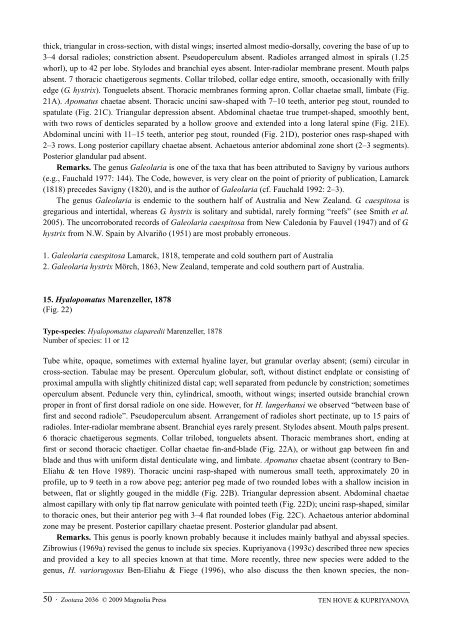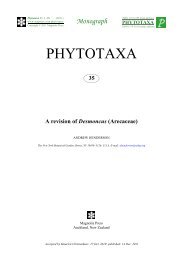Zootaxa, Taxonomy of Serpulidae (Annelida ... - Magnolia Press
Zootaxa, Taxonomy of Serpulidae (Annelida ... - Magnolia Press
Zootaxa, Taxonomy of Serpulidae (Annelida ... - Magnolia Press
You also want an ePaper? Increase the reach of your titles
YUMPU automatically turns print PDFs into web optimized ePapers that Google loves.
thick, triangular in cross-section, with distal wings; inserted almost medio-dorsally, covering the base <strong>of</strong> up to<br />
3–4 dorsal radioles; constriction absent. Pseudoperculum absent. Radioles arranged almost in spirals (1.25<br />
whorl), up to 42 per lobe. Stylodes and branchial eyes absent. Inter-radiolar membrane present. Mouth palps<br />
absent. 7 thoracic chaetigerous segments. Collar trilobed, collar edge entire, smooth, occasionally with frilly<br />
edge (G. hystrix). Tonguelets absent. Thoracic membranes forming apron. Collar chaetae small, limbate (Fig.<br />
21A). Apomatus chaetae absent. Thoracic uncini saw-shaped with 7–10 teeth, anterior peg stout, rounded to<br />
spatulate (Fig. 21C). Triangular depression absent. Abdominal chaetae true trumpet-shaped, smoothly bent,<br />
with two rows <strong>of</strong> denticles separated by a hollow groove and extended into a long lateral spine (Fig. 21E).<br />
Abdominal uncini with 11–15 teeth, anterior peg stout, rounded (Fig. 21D), posterior ones rasp-shaped with<br />
2–3 rows. Long posterior capillary chaetae absent. Achaetous anterior abdominal zone short (2–3 segments).<br />
Posterior glandular pad absent.<br />
Remarks. The genus Galeolaria is one <strong>of</strong> the taxa that has been attributed to Savigny by various authors<br />
(e.g., Fauchald 1977: 144). The Code, however, is very clear on the point <strong>of</strong> priority <strong>of</strong> publication, Lamarck<br />
(1818) precedes Savigny (1820), and is the author <strong>of</strong> Galeolaria (cf. Fauchald 1992: 2–3).<br />
The genus Galeolaria is endemic to the southern half <strong>of</strong> Australia and New Zealand. G. caespitosa is<br />
gregarious and intertidal, whereas G. hystrix is solitary and subtidal, rarely forming “reefs” (see Smith et al.<br />
2005). The uncorroborated records <strong>of</strong> Galeolaria caespitosa from New Caledonia by Fauvel (1947) and <strong>of</strong> G.<br />
hystrix from N.W. Spain by Alvariño (1951) are most probably erroneous.<br />
1. Galeolaria caespitosa Lamarck, 1818, temperate and cold southern part <strong>of</strong> Australia<br />
2. Galeolaria hystrix Mörch, 1863, New Zealand, temperate and cold southern part <strong>of</strong> Australia.<br />
15. Hyalopomatus Marenzeller, 1878<br />
(Fig. 22)<br />
Type-species: Hyalopomatus claparedii Marenzeller, 1878<br />
Number <strong>of</strong> species: 11 or 12<br />
Tube white, opaque, sometimes with external hyaline layer, but granular overlay absent; (semi) circular in<br />
cross-section. Tabulae may be present. Operculum globular, s<strong>of</strong>t, without distinct endplate or consisting <strong>of</strong><br />
proximal ampulla with slightly chitinized distal cap; well separated from peduncle by constriction; sometimes<br />
operculum absent. Peduncle very thin, cylindrical, smooth, without wings; inserted outside branchial crown<br />
proper in front <strong>of</strong> first dorsal radiole on one side. However, for H. langerhansi we observed “between base <strong>of</strong><br />
first and second radiole”. Pseudoperculum absent. Arrangement <strong>of</strong> radioles short pectinate, up to 15 pairs <strong>of</strong><br />
radioles. Inter-radiolar membrane absent. Branchial eyes rarely present. Stylodes absent. Mouth palps present.<br />
6 thoracic chaetigerous segments. Collar trilobed, tonguelets absent. Thoracic membranes short, ending at<br />
first or second thoracic chaetiger. Collar chaetae fin-and-blade (Fig. 22A), or without gap between fin and<br />
blade and thus with uniform distal denticulate wing, and limbate. Apomatus chaetae absent (contrary to Ben-<br />
Eliahu & ten Hove 1989). Thoracic uncini rasp-shaped with numerous small teeth, approximately 20 in<br />
pr<strong>of</strong>ile, up to 9 teeth in a row above peg; anterior peg made <strong>of</strong> two rounded lobes with a shallow incision in<br />
between, flat or slightly gouged in the middle (Fig. 22B). Triangular depression absent. Abdominal chaetae<br />
almost capillary with only tip flat narrow geniculate with pointed teeth (Fig. 22D); uncini rasp-shaped, similar<br />
to thoracic ones, but their anterior peg with 3–4 flat rounded lobes (Fig. 22C). Achaetous anterior abdominal<br />
zone may be present. Posterior capillary chaetae present. Posterior glandular pad absent.<br />
Remarks. This genus is poorly known probably because it includes mainly bathyal and abyssal species.<br />
Zibrowius (1969a) revised the genus to include six species. Kupriyanova (1993c) described three new species<br />
and provided a key to all species known at that time. More recently, three new species were added to the<br />
genus, H. variorugosus Ben-Eliahu & Fiege (1996), who also discuss the then known species, the non-<br />
50 · <strong>Zootaxa</strong> 2036 © 2009 <strong>Magnolia</strong> <strong>Press</strong><br />
TEN HOVE & KUPRIYANOVA
















